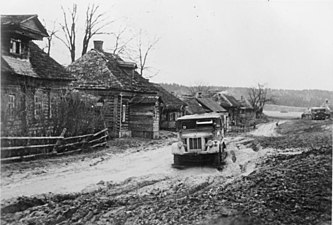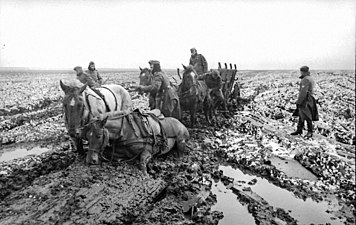| Revision as of 09:32, 7 March 2022 editThe Anome (talk | contribs)Edit filter managers, Administrators253,495 edits shorten shortdescTag: 2017 wikitext editor← Previous edit | Revision as of 09:40, 7 March 2022 edit undoThe Anome (talk | contribs)Edit filter managers, Administrators253,495 edits shorten shortdesc againTag: 2017 wikitext editorNext edit → | ||
| Line 1: | Line 1: | ||
| {{short description|Russian term for periods in spring and autumn when |
{{short description|Russian term for periods in spring and autumn when mud makes travel difficult}} | ||
| ]]] | ]]] | ||
| '''''Rasputitsa''''' ({{lang-rus|распу́тица|p=rɐsˈputʲɪtsə}}) is a Russian term for two seasons of the year, spring and autumn, when travel on unpaved roads or across country becomes difficult, owing to muddy conditions from rain or melting snow. "Rasputitsa" also refers to road conditions during both periods.<ref name = Comrades>{{cite book | '''''Rasputitsa''''' ({{lang-rus|распу́тица|p=rɐsˈputʲɪtsə}}) is a Russian term for two seasons of the year, spring and autumn, when travel on unpaved roads or across country becomes difficult, owing to muddy conditions from rain or melting snow. "Rasputitsa" also refers to road conditions during both periods.<ref name = Comrades>{{cite book | ||
Revision as of 09:40, 7 March 2022
Russian term for periods in spring and autumn when mud makes travel difficult
Rasputitsa (Russian: распу́тица, IPA: [rɐsˈputʲɪtsə]) is a Russian term for two seasons of the year, spring and autumn, when travel on unpaved roads or across country becomes difficult, owing to muddy conditions from rain or melting snow. "Rasputitsa" also refers to road conditions during both periods.
Effects
Civil
The term is applied to muddy road conditions in Belarus, Russia, and Ukraine, which are caused by the poor drainage of underlying clay-laden soils found in the region. Roads are subject to weight limitations and closures during the period in certain districts of Russia. The phenomenon was a hindrance in the early 20th century in the Soviet Union since 40% of rural villages were not served by paved roads.
Wartime
Rasputitsa seasons of Russia are well known as a great defensive advantage in wartime. Common nicknames include General Mud and Marshal Mud. A spring thaw probably saved Novgorod from conquest and sacking during the 13th-century Mongol invasion. During the French invasion of Russia in 1812, Napoleon found the mud a great hindrance.
On the Eastern Front during the Second World War, the months-long muddy period slowed the German advance during the Battle of Moscow (October 1941 to January 1942) and may have helped save the Soviet capital from German occupation. The advent of motorised warfare had the disadvantage that while tanks could operate effectively in summer or in winter, they proved less useful in spring and autumn, when the functioning of an efficient railway system came into its own.
Prior to the 2022 Russian invasion of Ukraine, some analysts identified the logistical challenges of the mud season as a likely hindrance to any large scale invasion in spring. When Russia did cross the border, many of its mobile units found themselves stranded in fields and limited to major roads, where resistance and logistical issues significantly slowed the advance towards Kyiv.
Similar terms
Similar terms are the Swedish "menföre" (bad going), and Finnish "kelirikko" (broken going), although both of these terms also apply to when water is too iced over for boats but not strong enough to cross on foot or in other vehicles. Finnish eastern dialects also have a loan term "rospuutto" (Template:IPA-fi) used in the same meaning as rasputitsa.
Gallery
-
 Village street near Moscow, November 1941
Village street near Moscow, November 1941
-
 Wehrmacht soldiers pulling an automobile through mud, November 1941
Wehrmacht soldiers pulling an automobile through mud, November 1941
-
 Wehrmacht horse carriage sunk in deep mud in Kursk Oblast, March–April 1942
Wehrmacht horse carriage sunk in deep mud in Kursk Oblast, March–April 1942
-
 October 2012 street scene in Sokol, Vologda Oblast, showing a combination of thick snow cover and waterlogged soil
October 2012 street scene in Sokol, Vologda Oblast, showing a combination of thick snow cover and waterlogged soil
See also
References
- ^ Siegelbaum, Lewis H. (2011). Cars for Comrades: The Life of the Soviet Automobile. Ithaca: Cornell University Press. p. 309. ISBN 9780801461484. Retrieved 2016-12-18.
- ^ FAQ regarding what made Napoleon fail in invading Russia, Napoleon -series website
- ^ Thiers, M. Adolphe (1864). History of the Consulate and the Empire of France under Napoleon. Vol. IV. Translated by D. Forbes Campbell; H. W. Herbert. Philadelphia: J. B. Lippincott & Co. p. 243.
whilst it was almost impossible to drag the gun-carriages through the half-frozen mud
(regarding November 20, 1812) -
May, Timothy Michael, ed. (2016). The Mongol Empire: A Historical Encyclopedia. Empires of the World. Vol. 1. Santa Barbara, California: ABC-CLIO. p. 65. ISBN 9781610693400. Retrieved 21 August 2019.
During the Mongol invasion of the Rus' principalities in 1238-1240, Novgorod escaped destruction by the Mongols due to an early spring, which transformed the routes to Novgorod into a muddy bog.
- Overy, Richard (1997). Russia's War. London: Penguin. pp. 113–114. ISBN 1-57500-051-2.
Both sides now struggled in the autumn mud. On October 6 the first snow had fallen, unusually early. It soon melted, turning the whole landscape into its habitual trackless state – the rasputitsa, literally the 'time without roads'.... It is commonplace to attribute the German failure to take Moscow to the sudden change in the weather. While it is certainly true that German progress slowed, it had already been slowing because of the fanatical resistance of Soviet forces and the problem of moving supplies over the long distances through occupied territory. The mud slowed the Soviet build-up also, and hampered the rapid deployment of men and machines.
-
Pinkus, Oscar (2005). "Death of Barbarossa". The War Aims and Strategies of Adolf Hitler. Jefferson, North Carolina: McFarland. p. 241. ISBN 9780786420544. Retrieved 21 August 2019.
By the time the Germans approached their major objectives such as Rostov, Moscow, or Leningrad the campaigning season was over and Barbarossa was off his horse. had not planned to fight in Russia during the fall and winter. He had stated in his Directive No. 21 that this was to be a 'lightning campaign' to be won in two to four months maximum. the cause of failure was the proposition that the Soviet Union could and would be defeated in a blitzkrieg.
-
Willmott, H. P. (1989). The Great Crusade: A New Complete History of the Second World War (revised ed.). Washington, D.C.: Potomac Books, Inc. (published 2008). p. 153. ISBN 9781597971911. Retrieved 21 August 2019.
While the Germans were to blame many factors, and particularly the rasputitsa, for the failure of Operation Taifun, the fact was that logistically the German attack on Moscow was in difficulty before it even began. German rail and road facilities were not sufficient to sustain the offensive beyond Smolensk .
- "Will Ukraine's muddy ground halt Russian tanks?". The Economist. 7 February 2022. Retrieved 5 March 2022.
- Roza, David (2 March 2022). "'Tanks and mud are not friends' — Ukraine's terrain is proving to be a problem for Russian armor". Task & Purpose. Retrieved 5 March 2022.
- "Ukraine: Why has Russia's 64km convoy near Kyiv stopped moving?". BBC News. 4 March 2022. Retrieved 5 March 2022.
- Joki, Leena (June 2011). "Mihin asti ilmoja piisaa?". Kielikuulumisia (in Finnish). No. 3/2011. Institute for the Languages of Finland. Archived from the original on 28 November 2021. Retrieved 28 November 2021.